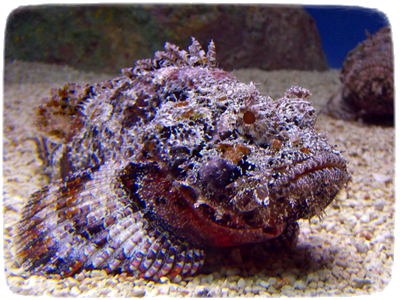Beneath the Waves
The ocean around the Philippines may appear inviting with its crystal-clear waters and picturesque beaches, but make no mistake, there are a few hidden dangers that can pose serious risks to both locals and tourists alike. From treacherous rip currents that can sweep even the strongest swimmers out to sea, to venomous jellyfish and sea urchins that lurk beneath the surface, the waters of the Philippines demand some caution and respect. Shark attacks, though rare, have been reported in certain areas, adding another layer of danger for those brave enough to venture into the depths.
Triggerfish

Divers should not continue to swim toward a large triggerfish that does not move away upon their approach. Divers should also be warned not to feed triggerfish by hand, as even small species are capable of inflicting bite wounds.
Scorpionfish

They are masters of disguise. Scorpionfish are also equipped with spines containing dangerous venom. When the spines pierce a predator, the venom is injected immediately at the point of contact. A sting from one of these spines can be potentially fatal to other animals and extremely painful to humans.
Lionfish

Although attractive and distinguishing for the lionfish, the fins and spines can inflict a severe sting resulting in localized pain, redness, and swelling. More advanced cases can involve neurological problems such as headaches, nausea, numbness, dizziness, and possible convulsions and paralysis.
Moray eels

Moray eels can be dangerous to humans due to their sharp teeth, powerful jaws, and toxins in their mucus. However, it is important to understand that moray eels dangerous encounters are not common, and they will not attack humans without provocation.
Sea Krait

These snakes are not seen often and are not aggressive however, the neurotoxic venom of the banded sea krait makes it among one of the most lethal creatures in our oceans. Its venom is 10 times more powerful than that of a rattle snake. The venom attacks the nervous system of the victim and can result in convulsions, paralysis, cardiac failure and even death.
Blue-ringed Octopus

They are very tiny but the symbiotic bacteria in blue-ringed octopus salivary glands produce tetrodotoxin (TTX). This substance is potently neurotoxic, blocking the transmission of nerve impulses. This stops muscles from being able to contract and has potentially deadly consequences.
Box Jellyfish

Box jellyfish, named for their body shape, have tentacles covered in biological booby traps known as nematocysts - tiny darts loaded with poison. People and animals unfortunate enough to be injected with this poison may experience paralysis, cardiac arrest, and even death, all within a few minutes of being stung.
Cone Snail

Cone snails possess a harpoon like tooth capable of injecting a potent neurotoxin that can be dangerous to humans. Cone snails live in shallow reefs partially buried under sandy sediment, rocks or coral in tropical and subtropical waters. Their stings can last for days.
Sea Urchin

Have strong sharp spines the can penetrate the foot if stepped on. Frequently spines break off and remain in the soft tissue, causing tenosynovitis, granulomas, or systemic symptoms such as nausea, vomiting, paresthesias, weakness, abdominal pain, syncope, hypotension, and respiratory distress.
Stingray

They have a venomous barb in their tail. Not only does the puncture from this barb itself cause injury and pain, but the stinger also releases a complex venom, which leads to intense pain at the puncture site. Uncommon effects of the venom include headaches, nausea and vomiting, fainting, low blood pressure, arrhythmias of the heart, and even seizures.
Crown of Thorns

Crown of thorns is highly toxic because its milky juice contains a toxin called phorbol ester. Phorbol esters can irritate the skin after contact with the human body, and ingestion can cause severe stomach pain, throat and oral irritation, and vomiting. It can leave permanent numbness in effected areas on some people.
Fire Worm

The million tiny white “fluffy” legs they have, when flared out, can penetrate human skin and they inject a very powerful neurotoxin into the area, which causes intense irritation and a painful burning sensation around the same area of contact.
Shark

Sharks are in all the world's oceans, but shark attacks are extremely rare. In fact, you are more likely to be struck by lightning than attacked by a shark.However, if attacked, these fish can kill by inflicting a severe bite.
Stargazer

Stargazers are venomous. Their venom comes from two large spines, which are set just above their pectoral fins. More impressive, is there third method of defense, electricity. This electrical defense comes from modified muscle tissues that are located just behind the eyes. This is used as a defense mechanism while they are swimming in the open, and any unsuspecting predators might be in for a shock of up to 50 volts if they try to attack.